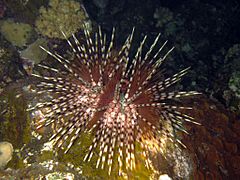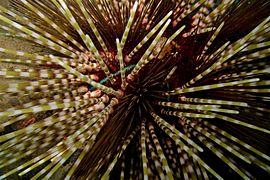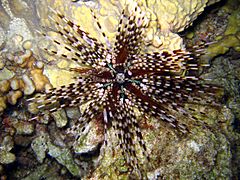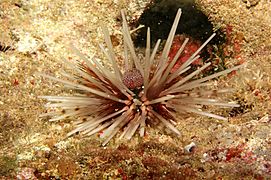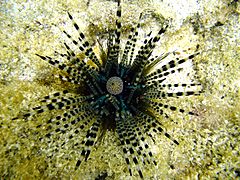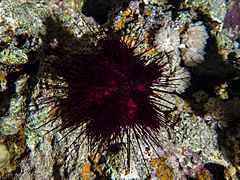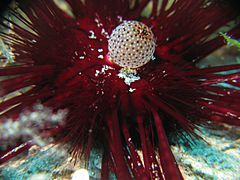Double spined urchin facts for kids
Quick facts for kids Double spined urchin |
|
|---|---|
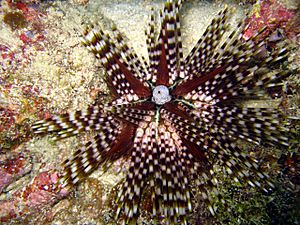 |
|
| Scientific classification | |
| Kingdom: | |
| Phylum: | |
| Class: | |
| Order: |
Diadematoida
|
| Family: |
Diadematidae
|
| Genus: |
Echinothrix
|
| Species: |
E. calamaris
|
| Binomial name | |
| Echinothrix calamaris Pallas, 1774
|
|
The banded sea urchin (also called the double spined urchin) is a type of sea urchin that lives in the ocean. Its scientific name is Echinothrix calamaris. It belongs to a group of sea urchins called the Diadematidae family.
Contents
How to Spot a Banded Sea Urchin
The banded sea urchin has a slightly oval body, which is like a hard shell. This shell can grow to about 5 cm across.
What makes this sea urchin special is that it has two different kinds of spines.
- One type is shorter and thinner. These spines can be yellow, brown, or dark in color. They can give a painful sting, but it's not dangerous.
- The other type of spine is longer and thicker. These spines often have bands of light and dark colors, like stripes. They can also be all dark or all white. These longer spines can reach 10 to 15 cm in length. They are hollow inside.
The spines are arranged in a way that shows five clear, bare spots on the middle of the shell. These spots look like a star and are often bright blue.
At the top of the sea urchin, there's a large, clear part called the anal papilla. It's usually whitish with tiny black and white dots. Around it, there's a ring of special cells that help the urchin see a little bit.
Sometimes, the banded sea urchin can look similar to its relatives, like Diadema setosum or Diadema savignyi. However, these other sea urchins are usually bigger and more uniformly black. They also have five white dots on top of their shell and an orange ring around their anus.
The banded sea urchin is most often confused with Echinothrix diadema. Young E. diadema can also have banded spines. But E. diadema has a very small, all-black anal papilla. Its spines also have a blue shine. The long spines of E. calamaris are more delicate and can be crushed easily because they are hollow. This is not true for E. diadema spines.
Different Looks: The Dark Form
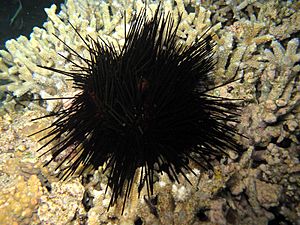
In some parts of the Indian Ocean, like the Red Sea, Seychelles, and Maldives, you might find a dark version of this sea urchin. Its spines are very dark and often don't have bands. They might even have a green shine. The body of this dark form can be reddish, sometimes completely red, especially in the Red Sea.
The anal papilla of the dark form is black, sometimes with white dots. It can be hard to tell apart from Echinothrix diadema because the dark form often doesn't have the blue star-shaped spots. Also, the spines of this dark form are sharper and stronger. You cannot crush them easily. Scientists think this dark form might be a different type or even a separate species.
Where Do They Live?
The banded sea urchin lives in warm, tropical waters across the Indo-Pacific region. You can find them from the eastern coast of Africa all the way to French Polynesia, including Hawaii and the Red Sea.
They live in waters from the surface down to about 70 meters (230 feet) deep. You can spot them in calm lagoons, on the slopes of coral reefs, and in channels.
What Do They Do?
These sea urchins are active at night. During the day, they like to hide in cracks in rocks or under them to stay safe.
Remember, their thinner spines can deliver a sting. However, this sting is not dangerous to humans.


